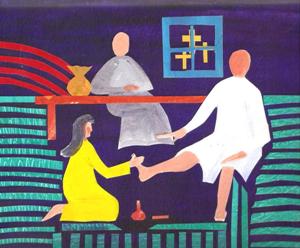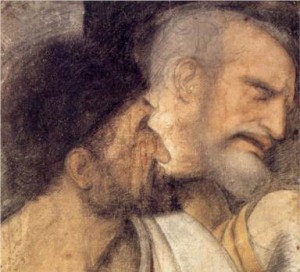He was an enigmatic figure. Dante assigned him to the lowest level of hell. Second century Gnostics on the other hand made him the hero of the story. Gospel writers never mentioned his name without also qualifying him as the betrayer of Jesus. One contemporary theologian noted that all groups trying to affect change have a Judas figure, a traitor who fails to keep the faith. His story of doom and gloom is told to keep the faithful on the straight and narrow for who knows, a little bit of Judas might lurk within our own hearts.
Very little is actually told about him aside from the fact that his father was named Simon from the town of Iscariot and that Judas was put in charge of the community purse. We are never told why he betrayed Jesus or what he hoped to gain politically for doing so. One account had him committing suicide while another described his belly gushing open in the middle of a field. We don’t know if he was married, had children, or what his occupation was. We know nothing of his inner life. We do know that he was chosen by Jesus to be an apostle and he spent three years living in close quarters with him and eleven other men. Even though the descriptive record of his life was sparse, he was compared to others in the gospel story and that comparison creates the opportunity for us to imagine and speculate what kind of man he was.
Judas and Judah
Judas is the Hellenized version of the name Judah. The original Judah was one of the twelve sons of Jacob the patriarch. Genesis 37 tells the story of a jealous rebellion he led to do away with his father’s favorite son Joseph. The sons of Jacob decided to throw their younger brother into a pit and let him die. When a caravan of Ishmaelites heading for Egypt showed up, Judah proposed that they sell their brother to them for the price of a slave. He then lied to his father saying Joseph had been attacked and killed by wild animals. Years later Joseph became prime minister for all of Egypt. When a famine struck the land, Jacob sent his sons to the storehouses of Egypt. They were shocked to discover that the one they betrayed and sold into slavery had become their savior. Mysterious forces were at work to transform their treacherous deeds into redemption for Israel. Those same forces reverberated down through the ages and created an echo in the life of Judas and God’s Son.
Judas and Mary
Mary, the younger sister to Martha, was one individual in the gospels who seemed to have an intuitive sense of Jesus’ emotional state. A few days before his death, Mary and Martha, along with their brother Lazarus, hosted a dinner party in their home for Jesus and his disciples. At some point during the evening, she must have sensed the Master’s distress. Maybe it was the sadness in his eyes or the strain in his voice. She quietly went to her room and retrieved her most priceless treasure, a bottle of expensive perfume that she may have been saving as her dowry. She took the sealed bottle, broke the neck and poured the contents on the feet of Jesus. Then she wiped his feet with her hair. It was an extravagant act of honor, hospitality, and love. Jesus was deeply moved by her kindness and received her anointing as a symbolic gesture. Judas, on the other hand, completely missed the symbolism. He saw the act as a waste of economic resources. Maybe he lacked the capacity to empathize with another. Maybe he was unable or unwilling to read another person’s inner world as Mary did. Most likely he was blind to the sub currents that flowed through his own inner world, a condition that Jesus called hardness of heart.
Judas and Peter
Their lives are forever linked. Both men were loved and called by Jesus to be with him and serve others. Both had important roles in the community of disciples; Judas as the treasurer and Peter as a primary leader. Both spent three years listening to him teach and watching him heal others. Both experienced disillusionment. And when Jesus was in his hour of need, both men failed him. Judas betrayed him and Peter denied him. Scripture tells us that both men were remorseful for their actions. But that is where the similarities stopped. Peter’s remorse led him to repent, confess his sins and in humbleness of heart return to Jesus. Judas on the other hand took matters into his own hands and committed suicide.
This reproduction of a chalk and charcoal drawing done by Leonardo da Vinci in 1495 was a study he did for his famous fresco of the Last Supper. Judas and Peter were seated together and the painting captures the moment when Jesus announced to his disciples that he would be betrayed by one of them. Peter leans in towards Jesus with a question forming on his lips. You can see sadness in his eyes. Judas on the other hand has his jaw clinched and his chin out in defiance. Though his traitorous plot had been exposed, he was determined to see it through. He failed to recognize that the revelation of his plan was a final invitation to repent.
The painting also asks a question. Why does one man return to Jesus after his failure while the other turns forever away? Da Vinci may hint at an answer by depicting two men of different age. Peter was painted older with gray hair. He had lived long enough to experience the folly of pride. He had learned to question his own motives. Judas on the other hand was painted younger. He was impatient for change and lacked self knowledge or the humility that might have saved his soul.
Judas and Jesus
The Scriptures do not tell us why Judas betrayed Jesus. Maybe he was hoping Jesus would restore Israel to its former glory and became disillusioned when that did not happen the way he imagined. Maybe he thought that by turning Jesus over to the authorities, he could force his hand. Or maybe he was consumed with personal ambition and when he saw the mission of Jesus come to a bloody end, he decided to strike the best deal for himself with the enemy. Regardless, the actions of Judas were in direct contrast to the actions of Jesus. Jesus served his disciples, including Judas by washing their feet, whereas Judas exploited Jesus by selling him to his enemies. Jesus offered his body and blood to save his friends. Judas, on the other hand, sought to save himself by collaborating with the corrupt demands of the religious and political establishment. Jesus protected the identity of his betrayer from the disciples who most certainly would have killed him, while Judas exposed the identity of Jesus with a kiss.
The offer of forgiveness from Jesus is never rescinded, even for those who betray him or commit suicide. Whether Judas chose to accept that offer when he stood before his maker, we don’t know, but the testament of his life implores us to never overestimate the gravity of our sin or underestimate the love of our God.




